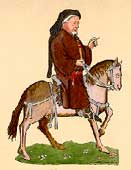The Canterbury Tales
 Geoffrey Chaucer is recognised as the first great English poet. Though there were other medieval poets, many of them known only as Anon, Chaucer’s body of work is unsurpassed and ranges widely in form and style. His most famous work is The Canterbury Tales, a collections of stories narrated by different characters as they make a pilgrimage from London to the shrine of St Thomas a Becket at Canterbury. This literary device is quite a common one, used by Italian medieval writer Boccaccio in his The Decameron, for example. It allows a framework where an author can write a number of different narratives with distinctive narrative viewpoints, which complement and contrast with each other. Chaucer’s wide choice of characters for his pilgrimage, from all different layers of society, gives the reader a fascinating view of medieval English life.
Geoffrey Chaucer is recognised as the first great English poet. Though there were other medieval poets, many of them known only as Anon, Chaucer’s body of work is unsurpassed and ranges widely in form and style. His most famous work is The Canterbury Tales, a collections of stories narrated by different characters as they make a pilgrimage from London to the shrine of St Thomas a Becket at Canterbury. This literary device is quite a common one, used by Italian medieval writer Boccaccio in his The Decameron, for example. It allows a framework where an author can write a number of different narratives with distinctive narrative viewpoints, which complement and contrast with each other. Chaucer’s wide choice of characters for his pilgrimage, from all different layers of society, gives the reader a fascinating view of medieval English life.
For a guide to Chaucer’s England, to flesh out the historical context, there are few better places to start than the British Library site’s overview.
More detailed discussion of different areas of The Canterbury Tales can be found by following the links below.
The General Prologue
A quick guide to some of the key figures
The Franklin’s Tale
The Wife of Bath’s Prologue and Tale
Challenging the Anti-Feminists
The Wife’s Relationships with her ‘Badde’ Husbands
Transgression in the Wife of Bath’s Prologue and Tale